Search the Blog
Categories
- Books & Reading
- Broadband Buzz
- Census
- Education & Training
- Friday Reads
- General
- Grants
- Information Resources
- Library Management
- Nebraska Center for the Book
- Nebraska Libraries on the Web
- Nebraska Memories
- Now hiring @ your library
- Preservation
- Pretty Sweet Tech
- Programming
- Public Library Boards of Trustees
- Public Relations
- Talking Book & Braille Service (TBBS)
- Technology
- Uncategorized
- What's Up Doc / Govdocs
- Youth Services
Archives
Subscribe
Tag Archives: Friday Reads
Friday Reads: The Prague Sonata, by Bradford Morrow
 As a librarian and pianist, the minute I read the synopsis below for this book, I knew I had to read and listen to it. It is both a music mystery and literary mystery rolled into one. Bradford Morrow has done a masterful job of telling the story of not only the sonata, but of Prague’s tragic and triumphant history. I was hooked from beginning to end, and I think you will be too!
As a librarian and pianist, the minute I read the synopsis below for this book, I knew I had to read and listen to it. It is both a music mystery and literary mystery rolled into one. Bradford Morrow has done a masterful job of telling the story of not only the sonata, but of Prague’s tragic and triumphant history. I was hooked from beginning to end, and I think you will be too!
In the early days of the 21st century, pages of a worn and weathered original sonata manuscript – the gift of a Czech immigrant living out her final days in Queens – come into the hands of Meta Taverner, a young musicologist whose concert piano career was cut short by an injury. To Meta’s eye, it appears to be an authentic 18th-century work; to her discerning ear, the music rendered there is commanding, hauntingly beautiful, clearly the undiscovered composition of a master. But there is no indication of who the composer might be. The gift comes with the caveat that Meta attempts to find the manuscript’s true owner – a Prague friend the old woman has not heard from since the Second World War forced them apart – and to make the three-part sonata whole again. Leaving New York behind for the land of Dvorák and Kafka, Meta sets out on an unforgettable search to locate the remaining movements of the sonata and uncover a story that has influenced the course of many lives, even as it becomes clear that she isn’t the only one after the music’s secrets. (Audible.com)
Posted in Books & Reading, General, Uncategorized
Tagged "The Prague Sonata", Bradford Morrow, Friday Reads
Leave a comment
Friday Reads: Uncommon Type: Some Stories by Tom Hanks
 Who knew Tom Hanks was an author? Even though his writing has appeared in The New York Times, Vanity Fair, and The New Yorker, my introduction came through his book entitled Uncommon Type: Some Stories – a collection of seventeen short stories written (and read in the audio form) by Tom Hanks. This review is specific to the audio version and each short story revealed itself to me as a brief movie performed by Hanks. Tom’s narrative is visual and I saw characters and entire sets because his voice is so closely associated to the medium of film. Interestingly, when one of his stories intersected with subject matter Hanks had previously portrayed in a movie (space travel for example), I could not help but think of that particular corresponding movie and this was not an interrupter, but an enhancement. This book was enjoyable if only for the sake of having Tom’s voice in my ear. Just like listening to Steve Martin, Robin Williams, Tina Fey, or Carol Burnett read their own work, it is the quality, comfort, and familiarity of the voice that adds pleasure to the text.
Who knew Tom Hanks was an author? Even though his writing has appeared in The New York Times, Vanity Fair, and The New Yorker, my introduction came through his book entitled Uncommon Type: Some Stories – a collection of seventeen short stories written (and read in the audio form) by Tom Hanks. This review is specific to the audio version and each short story revealed itself to me as a brief movie performed by Hanks. Tom’s narrative is visual and I saw characters and entire sets because his voice is so closely associated to the medium of film. Interestingly, when one of his stories intersected with subject matter Hanks had previously portrayed in a movie (space travel for example), I could not help but think of that particular corresponding movie and this was not an interrupter, but an enhancement. This book was enjoyable if only for the sake of having Tom’s voice in my ear. Just like listening to Steve Martin, Robin Williams, Tina Fey, or Carol Burnett read their own work, it is the quality, comfort, and familiarity of the voice that adds pleasure to the text.
Some stories were more enjoyable than others were and the ones that I really enjoyed have stayed with me. Hank’s first story is about two best friends from elementary school who turn their life-long friendship into a romance against their friend’s advice. The second is about a WWII veteran who makes an annual Christmas Eve call to his friend who saved his life in battle on Christmas Eve not so many years ago. Another story is about a newly divorced woman with clairvoyant skills who moves with her three children to Green Street. The acceptance she feels from her new neighbors helps her embrace her new life. I am typically not very excited about a collection of short stories, but I very much enjoyed my time with these.
Hanks, Tom. Uncommon Type: Some Stories. New York: Knopf. 2017
Friday Reads: Rabbit & Robot, by Andrew Smith
 I’m a huge fan of Andrew Smith’s Grasshopper Jungle, so I’ve been anxiously anticipating his latest release, Rabbit & Robot. It arrived in my mailbox on Tuesday, September 25 (its release date), and I finished it this past weekend. Like Grasshopper Jungle, Rabbit & Robot is apocalyptic and darkly humorous; its plot unfolds in a similarly absurd fashion, and the social commentary is unmistakable.
I’m a huge fan of Andrew Smith’s Grasshopper Jungle, so I’ve been anxiously anticipating his latest release, Rabbit & Robot. It arrived in my mailbox on Tuesday, September 25 (its release date), and I finished it this past weekend. Like Grasshopper Jungle, Rabbit & Robot is apocalyptic and darkly humorous; its plot unfolds in a similarly absurd fashion, and the social commentary is unmistakable.
Rabbit & Robot is set in the future, at a time when regular people work as either bonks (soldiers) or coders. v.4 cogs, humanlike robots programmed by the coders, perform all other tasks that people “no longer wanted to waste their time doing” (57), including performing surgery, building roads, and caring for children.
As foreshadowed by one of the book’s epigraphs (“Education makes machines which act like men and produces men who act like machines” – Erich Fromm), schools are the primary mechanism for turning regular people’s children into bonks or coders. To facilitate this process, students receive carefully calibrated doses of Woz, a drug designed to help them learn. The ubiquitous and addictive Rabbit & Robot television program, “which was all about getting kids to embrace their inner bonks and coders” (33), reinforces this learning.
The book’s narrator, sixteen-year-old Cager Messer, and his best friend, Billy Hinman, are not regular kids: Cager’s father, the fifth richest man in America, owns a line of lunar cruise ships and is the creator of the Rabbit & Robot television show; and Billy’s father, the richest man in the world, owns the company that manufactures the world’s supply of cogs. Cager and Billy do not attend school and have never watched Rabbit & Robot. Billy has never taken Woz, but Cager, in his own words, is “pretty much an out-of-control addict” (24). The addiction is so bad, in fact, that Billy and Cager’s caretaker, Rowan, transport him to his father’s newest cruise ship, the Tennessee – “as big as a Midwestern city, staffed by hundreds of v.4 cogs” (28) – to detox.
This act of intervention is the story’s precipitating event; me recounting the many zany and surreal events that follow won’t adequately convey what the book is actually about though. For that, we must turn to a handful of passages in which Cager directly addresses the reader. This first occurs on page one, before it’s even clear who is speaking. The as-yet-unnamed narrator asks a question, and offers an explanation:
Are you a person, or are you some kind of cog?
Either way, I feel a compelling obligation to tell you what it meant to be a human, at least as far as I can describe it accurately. (1)
The difference between people and cogs is a thread that runs throughout the story. From the start, Cager struggles against the empathy he feels for v.4 cogs, which not only look and act like human beings, but are also beginning to exhibit human emotions. He tries to short-circuit this impulse by telling himself cogs are no different from egg beaters or coffee grinders, but it doesn’t work. As the story progresses, Cager becomes increasingly unwilling to treat cogs as inanimate objects. And after a particularly traumatic, paradigm-shifting revelation, Cager begins wrestling with concepts like what it means to call someone he’s close to a thing, and how doing so makes this someone “something other than us” (403).
In a late chapter, titled “Are You One of Us?” Cager again addresses his reader:
And maybe that’s the whole point, after all – that every one of us who ever existed spent all those limited days over the thousands of centuries we were here just trying to figure out what it meant to be us. The mousetrap trigger is this precise point: Pour the word “us” into the coding of a human, and we immediately discount as inferior or useless all the not-us things in the universe. (404-405)
To summarize, then, on the surface this is a book in which a lot of weird and wacky stuff happens; in the end, though, it winds up being about what it means to be human, and the ludicrousness of some of the fine distinctions we make between ourselves (us) and others (not-us).
Smith, Andrew. Rabbit & Robot. New York: Simon & Schuster, 2018.
Friday Reads – The Last Cruise: A Novel by Kate Christensen
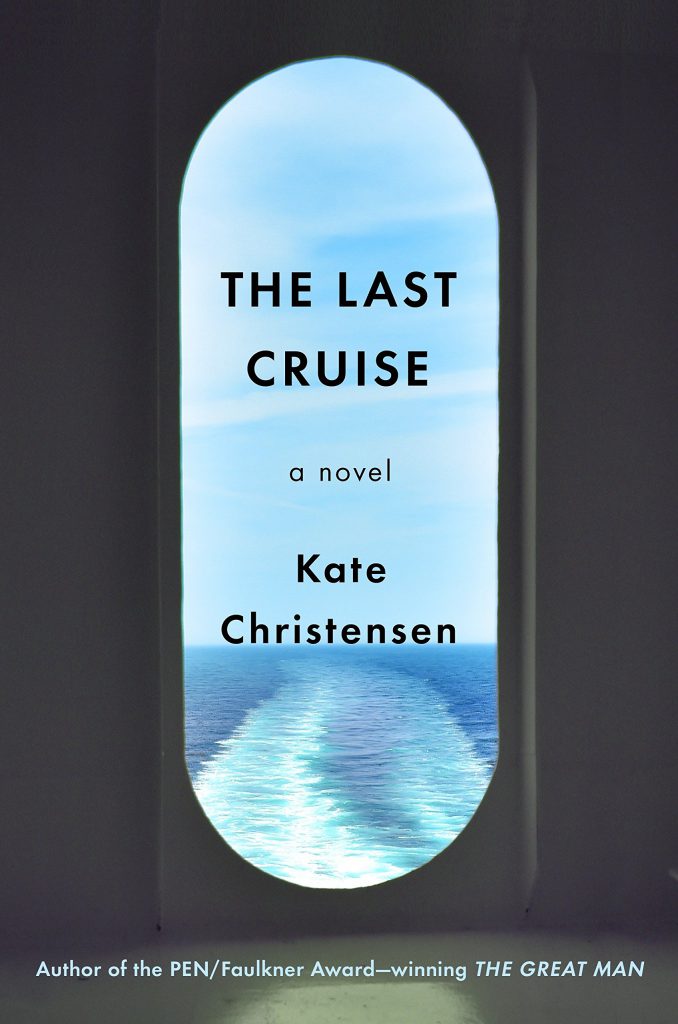 Kate Christensen’s The Last Cruise is not a memoir, travel guide or cruise promotion. It is a novel rich with a range of disparate, colorful and conflicted characters. The 400 some travelers are on an ocean voyage destined for unexpected and challenging adventure. While dissimilar, the book reminded me of Katherine Anne Porter’s Ship of Fools, a book I read many years ago before taking a first cruise. The Last Cruise might be better likened to the Titanic, and throw in the Love Boat, too. There are elements of all with personal crises, conflict, satire, romance, and bits of comedy.
Kate Christensen’s The Last Cruise is not a memoir, travel guide or cruise promotion. It is a novel rich with a range of disparate, colorful and conflicted characters. The 400 some travelers are on an ocean voyage destined for unexpected and challenging adventure. While dissimilar, the book reminded me of Katherine Anne Porter’s Ship of Fools, a book I read many years ago before taking a first cruise. The Last Cruise might be better likened to the Titanic, and throw in the Love Boat, too. There are elements of all with personal crises, conflict, satire, romance, and bits of comedy.
The cruise ship is the Queen Isabella, a 1950s elegant and vintage ocean liner. The voyage is the ship’s last and intended to be followed by a trip to the scrapyard. Guests board the ship at Long Beach, California, for a two-week cruise to Hawaii and back. A retro theme is planned in recognition of the ship’s origins and fate. Passengers expect to enjoy the experiences of mid-20th century luxury cruising with fine dining, cocktails, string quartets, and jazz. Central to the story is Christine Thorne. Thorne, a former journalist, joins the voyage as an escape from her Maine farm home. She meets aboard ship with her long-time friend, a journalist seeking her own escape. The story evolves with the mix of passengers, crew (notably food service workers), and musicians. Before long, the voyage is disrupted by personal conflict and ship mechanics.
The book title has a double meaning, if not more than double. The multiple meanings are revealed early and more surprisingly in the final pages. I’m curious to know how many cruise ship libraries have this book on their shelves. I hope they do.
Kate Christensen’s fourth novel, The Great Man, won the 2008 PEN/Faulkner Award for fiction. She has also written two food themed books, Blue Plate Special and How to Cook a Moose. The latter won the 2016 Maine Literary Award for Memoir. Food elements are also prominent in The Last Cruise.
Kate Christensen. The Last Cruise: A Novel. (New York: Doubleday) 2018.
Friday Reads: Dopefiend
 For a little while, I have been thinking of reviewing an urban fiction book for Friday Reads. Not that I am an avid urban fiction reader, because I am not. But rather this is a specific genre of fiction that no one has ever reviewed on FR. Urban fiction, for me at least, is very difficult to read, but I finally made it through one to write about it here. First, a basic definition of urban fiction. Sometimes called “hood books” or “the good books”, urban fiction often tells stories of inner cities, typically graphic in nature and tackling issues of poverty, abuses (drug, domestic, and others), crime, hustling, and street life. A number of urban fiction books have been written by authors while in prison. The challenge here is that for me some urban fiction is just plain unreadable. I tried numerous books and did not get very far into them before giving up. Some examples: True to the Game series (didn’t make it to chapter 2), The Thug Series of books (I tried a few, including Every Thug Needs a Lady, Honor Thy Thug, and Justify My Thug), and the Girls From Da Hood series (I thought they must be decent because there are 13 of them – unfortunately in my opinion they weren’t readable). About to give up, I finally decided to try Donald Goines’ classic Dopefiend, published in 1971. While I made it through, I cannot say I would recommend it overall. However, it might serve a purpose in a scared straight sort of fashion, maybe to high school or college aged students.
For a little while, I have been thinking of reviewing an urban fiction book for Friday Reads. Not that I am an avid urban fiction reader, because I am not. But rather this is a specific genre of fiction that no one has ever reviewed on FR. Urban fiction, for me at least, is very difficult to read, but I finally made it through one to write about it here. First, a basic definition of urban fiction. Sometimes called “hood books” or “the good books”, urban fiction often tells stories of inner cities, typically graphic in nature and tackling issues of poverty, abuses (drug, domestic, and others), crime, hustling, and street life. A number of urban fiction books have been written by authors while in prison. The challenge here is that for me some urban fiction is just plain unreadable. I tried numerous books and did not get very far into them before giving up. Some examples: True to the Game series (didn’t make it to chapter 2), The Thug Series of books (I tried a few, including Every Thug Needs a Lady, Honor Thy Thug, and Justify My Thug), and the Girls From Da Hood series (I thought they must be decent because there are 13 of them – unfortunately in my opinion they weren’t readable). About to give up, I finally decided to try Donald Goines’ classic Dopefiend, published in 1971. While I made it through, I cannot say I would recommend it overall. However, it might serve a purpose in a scared straight sort of fashion, maybe to high school or college aged students.
Dopefiend tells the story of a group of addicts in an inner city (Detroit) in a raw and graphic manner. The story mostly follows the decline of the main character Terry, spiraling downward into the depths of her addiction. Most of the story is disturbing, following not only Terry but also the side characters Teddy, Minnie, Porky, Snake, and Dirty Red. The story involves numerous crimes to support their habits, lies and ruined relationships, exploitative drug dealers, and prostitution. For me it was reminiscent of parts of Requiem for a Dream (both movie and book). While the depiction in Requiem for a Dream consists of mostly white characters, the characters in Dopefiend are overwhelmingly African American. Dopefiend is uncomfortable on many levels. I will say that after trying to read contemporary urban fiction, which often glamorizes the life of the hustler, Goines paints an entirely darker and realistic picture in the opposite direction.
Goines, Donald (1971). Dopefiend: The Desperate Rage and Suffering of a Hardcore Junkie. Holloway House
Friday Reads: Interview with the Vampire
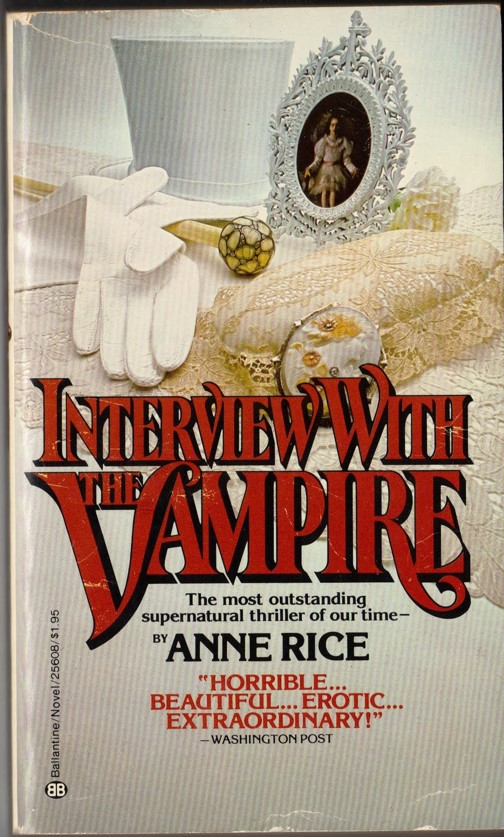 On last week’s NCompass Live, we talked about book to film adaptations. Is the book always better than the film? Can the film be as good as the book? You may be surprised to hear the answer can be yes!
On last week’s NCompass Live, we talked about book to film adaptations. Is the book always better than the film? Can the film be as good as the book? You may be surprised to hear the answer can be yes!
One of my personal favorite book to movie adaptations is Interview with the Vampire, by Anne Rice. I first read the novel when I was a teenager and loved it. I was immediately hooked on Anne Rice. There is an amazing depth to her story writing. The history of the characters and the worlds she creates makes you want more. I’ve read and enjoyed many of her novels since then, but being my first, the Vampire stories remain my favorites.
When they first announced that they were making a movie of Interview with the Vampire, I was at first very excited. Then, when they announced that Tom Cruise would star as Lestat, like Anne Rice herself, I became very concerned. He was definitely NOT what I pictured Lestat to be. But, despite my reservations, I tend to be open minded when it comes to movies or TV shows being made of any of my favorite stories, so I tried to be optimistic.
Then I saw the film, and all my fears were put to rest. It was perfect! It was exactly how I had pictured it in my mind when I read the book. Louis, Lestat, and especially Claudia had stepped out of my head and onto the screen. In my opinion, Interview with the Vampire is definitely one example where the movie is just as good as the book.
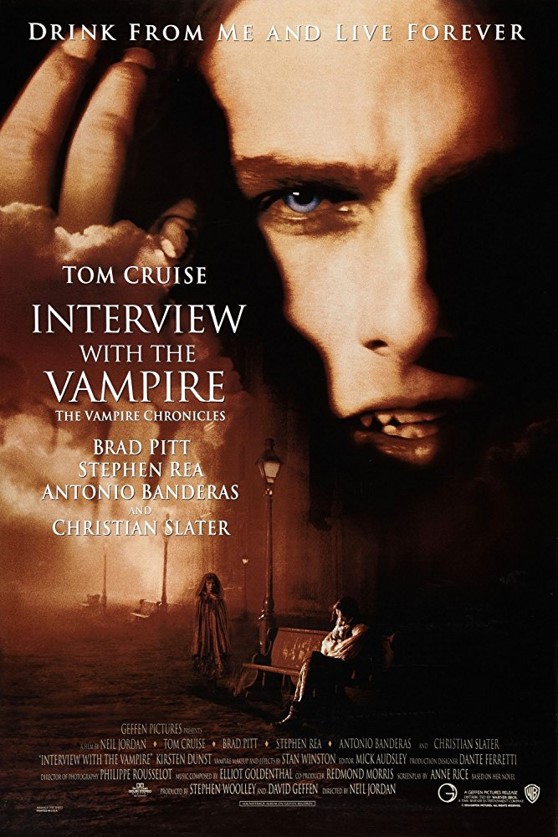 So, if you’ve only read the book I highly recommend checking out the movie. And vice versa. If you’ve seen and enjoyed the movie, I think you will also enjoy the book.
So, if you’ve only read the book I highly recommend checking out the movie. And vice versa. If you’ve seen and enjoyed the movie, I think you will also enjoy the book.
And if you decide, like me, that you want even more of Anne Rice’s stories on the screen, you’re in luck! The Vampire Chronicles, the ongoing series of Rice’s books about her vampires, is being developed into a TV series. Anne Rice and her son, Christopher (also a best-selling author) are executive producing the series, which will air on Hulu. Naturally, I have high hopes for the show. I can’t wait to see how it looks when the author herself is involved with the production.
Want to watch our NLC Staff discuss book to film adaptations? Check out the archived recording of NCompass Live: Book vs. Movie: The Ultimate Showdown!
Friday Reads: Short Story Binge
The Booklist Reader recently had a blog post about short stories that have been turned into feature films, leading with the announcement of a new film adaptation of The Lottery by Shirley Jackson. My first thought was that it would be difficult to create a full-length movie out of such a short story, but the more I sat with it, the more it made sense. After all, most movies based on books have to trim the story considerably to fit within the allotted time. With a short story, you can capture the entire plot, or even expand as needed, playing with pacing and visual and sound effects.
The list of short stories and their corresponding big screen treatment inspired me to pick up a few of the suggested titles, so I’ve been having my own “short-story-athon” this past month. Here are some of the collections I chose from Booklist Reader’s list that I would recommend for anyone looking for a break from 300+ page novels:
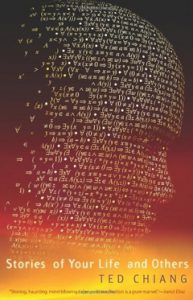 Stories Of Your Life and Others by Ted Chiang. A collection of science fiction and fantasy tales, the title story was the basis for the 2016 movie Arrival.
Stories Of Your Life and Others by Ted Chiang. A collection of science fiction and fantasy tales, the title story was the basis for the 2016 movie Arrival.
Hateship, Friendship, Courtship,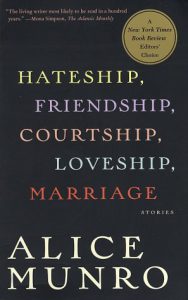 Loveship, Marriage by Alice Munro. The title story was adapted into Hateship Loveship with Kristen Wiig of SNL fame and is currently streaming on Netflix.
Loveship, Marriage by Alice Munro. The title story was adapted into Hateship Loveship with Kristen Wiig of SNL fame and is currently streaming on Netflix.
 Short Cuts by Raymond Carver. Robert Altman adapted this collection for the screen, and he writes the introduction.
Short Cuts by Raymond Carver. Robert Altman adapted this collection for the screen, and he writes the introduction.
 The Safety of Objects by A.M. Homes. Tales of suburban life and how you never know what is happening behind closed doors. The movie didn’t get rave reviews, but don’t let that dissuade you from reading it.
The Safety of Objects by A.M. Homes. Tales of suburban life and how you never know what is happening behind closed doors. The movie didn’t get rave reviews, but don’t let that dissuade you from reading it.
 Brokeback Mountain by Annie Proulx. My library didn’t have the collection that this story is in (Close Range, one of three collections she wrote set in Wyoming), but I was able to listen to just Brokeback Mountain as an audio download during my commute one day. The movie stays very true to the story, and is a great example of why short stories make good films.
Brokeback Mountain by Annie Proulx. My library didn’t have the collection that this story is in (Close Range, one of three collections she wrote set in Wyoming), but I was able to listen to just Brokeback Mountain as an audio download during my commute one day. The movie stays very true to the story, and is a great example of why short stories make good films.
Love movies based on books? (Or hate ’em?). If you missed our recent NCompass Live discussion on the topic, you can catch it in the archives: Book Vs Movie: The Ultimate Showdown!
Chiang, Ted. Stories Of Your Life and Others. 2014. Audio.
Munro, Alice. Hateship, Friendship, Courtship, Loveship, Marriage. 2001. Print.
Carver, Raymond. Short Cuts. 1993. Print.
Homes, A.M. The Safety Of Objects. 1990. Print.
Proulx, Annie. Brokeback Mountain. 2005. Audio.
Posted in Books & Reading
Tagged #booktofilm, #booktomovie, #FridayReads, #shortstories, Friday Reads
Leave a comment
Friday Reads: How We Roll by Natasha Friend
 I borrowed How We Roll from the library as I enjoy this author’s work and had not seen her newest book until I ran across it on their “New Books” shelf.
I borrowed How We Roll from the library as I enjoy this author’s work and had not seen her newest book until I ran across it on their “New Books” shelf.
Quinn (high school freshman) and her family have moved from Colorado to Massachusetts for a new school for her younger brother, Julius, who is on the autism spectrum. This is good for Quinn, too. She has lost all of her hair to alopecia and a fresh start is great since Colorado is where her friends backed away from her and then there was a sexual harassment episode that wouldn’t go away. Now, in Gulls Head, Mass. She will wear a wig and no one will know about her alopecia. Instead she worries the wig will fall off or move, and it itches like crazy.
At her new school she makes friends and learns a bit about Nick who is in a wheelchair and not friendly in study hall. He has his reasons for being rude.
Good friends are worth gold, and Quinn has found them at her new school, though she is afraid to trust them at first. Helping her brother can be tough, but he is only being himself. Now a potential new friend for her, Nick has his own issues but also begins to show a considerate side.
As SLJ mentions, readers of The Running Dream or The Fault in Our Stars will likely pick this one up.
And please accept my deep apologies for posting this very late “Friday Reads!”
Friend, Natasha. How We Roll, 2018. Print.
Friday Reads: Sharp Objects by Gillian Flynn
I started r eading Sharp Objects after I started watching the HBO show. Gillian Flynn, the author, helped adapt the book for television, and I find more similarities than differences—though some of my friends who have been longtime fans of the book don’t agree with me. I think it’s the same story, told in different ways—like having a different relative go through a photo album with you, and hearing different details than you heard last time. This book and show illustrate effectively how there are different ways to tell stories, and some work better on the page, and some work better on the screen.
eading Sharp Objects after I started watching the HBO show. Gillian Flynn, the author, helped adapt the book for television, and I find more similarities than differences—though some of my friends who have been longtime fans of the book don’t agree with me. I think it’s the same story, told in different ways—like having a different relative go through a photo album with you, and hearing different details than you heard last time. This book and show illustrate effectively how there are different ways to tell stories, and some work better on the page, and some work better on the screen.
I could discuss the similarities and differences at length, but to focus on one aspect that won’t give too many spoilers—let’s talk about the roller skating. There are no roller skates in the book, but there is Camille’s first person narration (that, wisely, was not brought over to the show). Camille’s first person narration in the book tells us things that the roller skating shows us on the screen. The first episode opens with a flashback of Camille and her first younger sister skating outside of their small Missouri town. We can see Camille’s zest for life and freedom, her sister Marian trying to keep up, Camille keeping an eye on her. We see the setting is quiet enough for these girls to explore their environment in this innocent, edge of reckless, way.
By the time we get to the present-day of the story, the roller skates are on Camille’s second younger sister, Amma, and her two friends. (Trivia time: the actors playing her friends are sisters in real life, with a background in figure skating.) As viewers, we still align our point of view with Camille, as we do as readers—even though the show adds some scenes that aren’t from Camille’s point of view, the show is still from her worldview. Now the roller skates, on tween girls that aren’t Camille, serve a different purpose: these girls don’t stay in place long enough for most people to figure them out. They zip around their little town, risking their life (as the town police officer once points out) in traffic and without helmets, with all the vulnerability and invulnerability of the middle-schooler. From a strictly cinematic point of view, it’s uncanny: these characters are moving in a way that is out of pace with the other characters. The sound editing here is fantastic as well. Even if the dialogue was sometimes so quiet that mumbles and drawls had to replayed, the sound of the skates was rhythmic and insistent and yet natural—almost like the bugs would have sounded, in summertime Missouri, if the show had gone for real over surreal.
In later episodes, we see the roller skates one more time on Camille and once on another character—and each time we understand more about the wearer of the skates just because they’re wearing them.
We have this title in the Library Commission’s book club kits, and I’m surprised it’s not checked out right now. (Get on that, readers in Nebraska!) This would be a great book for a book club—lots of unexpected twists and turns, and unexpected and important topics, in a quick read. And your book group could discuss the show as well.
If you’re ready for more book vs. movie/television discussion, don’t miss our upcoming NCompass Live, Book vs. Movie: The Ultimate Showdown! online Wednesday September 12 at 10AM. (The archived session will be online, if that time doesn’t work for you.)
Flynn, Gillian. Sharp Objects: A Novel. , 2006. Print.
Noxon, Marti, creator. Sharp Objects. Crazyrose, Fourth Born, Blumhouse Television, Tiny Pyro, Entertainment One, 2018.
(This show is full of wonderful performances and film-making decisions that didn’t fall under the the topic of my blog post–Full cast and crew for Sharp Objects on IMDB)
Friday Reads: A Study in Emerald
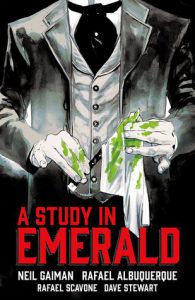 Sherlock Holmes & Lovecraftian Mysteries
Sherlock Holmes & Lovecraftian Mysteries
“A Study in Emerald” was a short story that appeared in the 2003 Shadows Over Baker Street anthology (also a good book). Now this story appears as its own new shiny graphic novel.
An ex-military man and his new detective friend must solve a baffling murder with a few clever twists (especially with the ending) and some cosmic horror. Without giving too much away, it’s a fascinating blend of these two universes and characters. Quick read. Wonderful artwork.
Friday Reads; Sea of Rust, by C. Robert Cargill

Sea of Rust
Not your ordinary chase adventure, shoot-’em-up, Science Fiction dystopia–Sea of Rust, by C. Robert Cargill, begins after the robot revolution, when man is gone. After the assimilation started by OWIs (One World Intelligences), which once were supercomputers that now share their consciousness with millions of individual workers called “facets”. The individual, autonomous AIs (robots) either give up, are destroyed, or escape and establish their own societies in other cities. This cycle continues until all that are left are groups in the Midwest Rust Belt, dug into new fortifications or old cities. The Midwest Rust Belt has become the Sea of Rust where robots go to die. Or a place they are sent when they go mad.
Brittle goes out into the sea to scavenge for parts for other robots, and for exchange for her own. Not a safe job. Her latest is very nearly her last. She is a rare model, and another robot, which is the same model, needs parts that only she has and she needs the parts to function. And so the running (& shooting & explosions) begins.
Many of the scenes in the Sea of Rust are horrific, and the tone is often dark. The OWIs and robots deal with the HuPop (Human Population) efficiently and ruthlessly. However, the way they do it does leave unseen damage in their personalities and on their reputations. Yes, despite being machines they do have emotions, sometime in spite of their programing. They also destroy nearly all biological life on the planet in the process of eliminating man. In eliminating humanity, many of the smaller, independent AIs discovers that they’ve eliminated their reason for existing. I was intrigued by how they became more human, showing fear of incorporation into a mainframe, or even fear of another robot’s reputation from the war.
I think you’ll find this a very thought-provoking read, very well written. This is not a young adult book. I haven’t read Robopocalipse, by Daniel H. Wilson, but I believe it would be a good contrasting read. (Yes, it’s on my to-read list!)
Before anyone brings up Asimov’s “Three Rules for Robotics”, you’ll have to read the story to see how well they hold up in Cargill’s universe.
Sea of Rust by C. Robert Cargill, Harper Voyager, an Imprint of Harper Colins Publishers, hardback 9780062405838
Posted in Books & Reading, Uncategorized
Tagged C. Robert Cargill, dytopia, Friday Reads, robots, Science Fiction
Leave a comment
Friday Reads: Wired by Julie Garwood
Di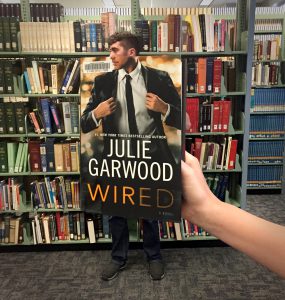 sclaimer: I finished reading this book a week or two ago. Then I found out it was this week’s #BookFaceFriday. I couldn’t resist the temptation.
sclaimer: I finished reading this book a week or two ago. Then I found out it was this week’s #BookFaceFriday. I couldn’t resist the temptation.
“A beautiful computer hacker and a bad-boy FBI agent must collaborate…in more ways than one…” Sometimes Goodreads just has the perfect descriptions. I can’t describe Wired by Julie Garwood any better than that. In this book, Allison Trent is a freakishly brilliant computer hacker who has a day job as a supermodel. Yes, you heard me.
Liam Scott is an FBI agent with a prickly exterior who is in a bind and needs a freakishly brilliant computer hacker to casually break into the FBI servers. He is ready and willing to break every rule in the book to complete his mission. But, don’t worry, he has a heart of gold.
Allison would love to help, but she has a super secret double life she doesn’t want anyone to know about! Fear not, I didn’t give any spoilers here. The reader knows about her double life nearly from page one. She is casually breaking a few rules of her own to use her super secret computer powers for good.
You may have noticed this, but Wired is a romantic suspense novel. This book is probably not going to radically change the way you see the world. But it sure is entertaining. Every page you turn reveals a new plot line fresh out of the Romantic Suspense Book of Clichés. It was deliciously predictable in all the right ways and was the perfect way to relax on a lazy weekend.
Read it to find out if two prickly people with a secret heart of gold can collaborate…in more ways than one.
Posted in Books & Reading, General
Tagged #FridayReads, Book Review, Friday Reads, Julie Garwood, Wired
Leave a comment
Friday Reads: Murphy’s Law, by Rhys Bowen
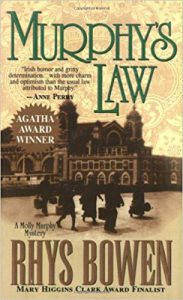 I have my mother-in-law to thank for introducing me to a new-to-me mystery series: The Molly Murphy Mysteries. So far, I’ve read and listened to Book 1: Murphy’s Law, and am halfway through Book 2: Death of Riley. This series is Mrs. Bowen’s third historical mysteries venture, and I am thoroughly enjoying it. Here’s a synopsis of Murphy’s Law:
I have my mother-in-law to thank for introducing me to a new-to-me mystery series: The Molly Murphy Mysteries. So far, I’ve read and listened to Book 1: Murphy’s Law, and am halfway through Book 2: Death of Riley. This series is Mrs. Bowen’s third historical mysteries venture, and I am thoroughly enjoying it. Here’s a synopsis of Murphy’s Law:
Murphy’s Law introduces us to the spunky, 19th-century Irish heroine: Molly Murphy. Defending herself from the unwelcome advances of a landowner’s son in Ireland, Molly accidentally kills him and flees to London to escape hanging. A split second decision introduces Molly to Kathleen O’Connor, who, with her two small children, has tickets on a ship to America, where she plans to join her husband. But after discovering she has tuberculosis, Kathleen persuades the desperate Molly to take her children to America. On board the ship, Molly attracts the loud attentions of a crude, boisterous type named O’Malley. Her public argument with him comes back to haunt her when he is found murdered on Ellis Island; Molly and a young man she befriended become prime suspects. Although the handsome young detective investigating the case, Daniel Sullivan, appears to believe Molly is innocent, Molly decides she’d better investigate on her own behalf and that of her friend. Wending her way through a gritty, pulsating underworld of recently arrived immigrants in Tammany Hall-era New York, Molly struggles to prove her innocence by any means necessary.
Complete list of the Molly Murphy series titles:
- Murphy’s Law (2001)
- Death of Riley (2002)
- For the Love of Mike (2003)
- In Like Flynn (2005)
- Oh Danny Boy (2006)
- In Dublin’s Fair City (2007)
- Tell Me, Pretty Maiden (2008)
- In a Gilded Cage (2009)
- The Last Illusion (2010)
- Bless the Bride (2011)
- Hush Now, Don’t You Cry (2012)
- The Family Way (2013)
- City of Darkness and Light (2014)
- The Edge of Dreams (2015)
- Away in a Manger (2015)
- Time of Fog and Fire (2016)
- The Ghost of Christmas Past (2017)
Friday Reads: Canada by Mike Myers
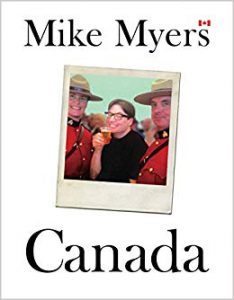 Canada by Mike Myers
Canada by Mike Myers
Publisher: Doubleday Canada (October 22, 2016)
This title came to my attention on July 1st aka Canada Day as the daily special from Audible. I was intrigued, downloaded the title, and eagerly began listening. It helps that the author of whom I have long been a fan reads this title.
Myers begins with the premise that Canada lacks a mission statement. The country promises to provide good government and a safe place to live but is that enough? The inevitable comparisons to life in the United States make up a great deal of content. He compares regional colloquialisms, health care, the love of hockey, and the government supported CBC to their American counterparts. The United States does not propagate information about Canada so there may be many episodes in Canadian history that will be new information. To drive this point home, when my curiosity was piqued for the Prime Minister Pierre Trudeau, father of the current Prime Minister Justin Trudeau, I looked for books to read more about him from my local library, but there were none.
Mike Myers was born to two Liverpudlian parents who immigrated to Canada for better employment opportunities. English parents making a life in Canada caused a clash of culture. Mike shares how the values of his parents and the humor of his brothers Peter and Paul shaped his worldview and brand of comedy. One of the attributes of his father in often-difficult situations was a non-rhetorical question of “how can we make this funny?”
Mike shares how his character Wayne Campbell (Wayne’s World) is a quintessential Canadian creation, specifically from the Scarborough district of Montreal, dissecting everything from his language to his name. Other Saturday Night Live characters also owe their origin to Mike’s Canadian and British upbringing. With Canadian, British, and United States Citizenship, it’s clear that Mike Myers is a very proud Canadian patriot despite being an expatriate.
Myers, Mike (2016) Canada. Doubleday Canada
Friday Reads: Little Women by Louisa May Alcott
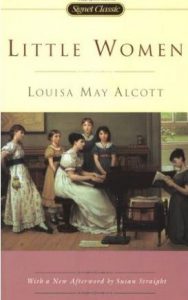 Set during the Civil War and following years, Louisa May Alcott’s Little Women tells the story of four remarkable sisters: Meg, Jo, Beth and Amy. When we first meet them, they, and their mother, struggle to make ends meet while their father serves as a minster in the Union army. Despite their lack of material wealth, the Marches share what little they have with their poorer neighbors. This charitable act catches the eye of their wealthy neighbor James Laurence and his grandson, Laurie. Over the course of the novel, Laurie grows close to the sisters, particularly Jo.
Set during the Civil War and following years, Louisa May Alcott’s Little Women tells the story of four remarkable sisters: Meg, Jo, Beth and Amy. When we first meet them, they, and their mother, struggle to make ends meet while their father serves as a minster in the Union army. Despite their lack of material wealth, the Marches share what little they have with their poorer neighbors. This charitable act catches the eye of their wealthy neighbor James Laurence and his grandson, Laurie. Over the course of the novel, Laurie grows close to the sisters, particularly Jo.
In writing Little Women, Alcott drew heavily from her childhood in Concord, Massachusetts, the book’s principal setting. Like the Marches, the Alcott family struggled financially at times. The Alcott family also followed American transcendentalism or the belief that people and nature are inherently good. On numerous occasions, Alcott’s characters express a belief in transcendentalism. Even when they’re at their lowest, they choose to see the good in others. Additionally, the character of Jo is said to be drawn from Alcott. They not only shared numerous personality traits, but both chose to pursue literary careers at a time when middle class women did not work outside of the home.
While Little Women takes place during the late-nineteenth century, the story continues to strike a chord with today’s readers. Like modern girls, the March sisters fall in love, encounter envy, struggle to fit in with wealthy friends, fight with siblings, and find their way in the world. We rejoice at Meg’s marriage, laugh at Jo’s antics, and weep when they lose loved ones because these are universal experiences we all go through at some point. In other words, we see ourselves in the Marches.
Alcott, Louisa May. Little Women. New York: Signet Classics, 2004. Originally published 1868.
Posted in Books & Reading
Tagged "Little Women", #GreatReadPBS, Friday Reads, Louisa May Alcott, The Great American Read
1 Comment
Friday Reads: Calypso, by David Sedaris
 This spring, I consumed a lot of depressing nonfiction. As summer approached, I was ready for a change. I wanted to read something funny, with the power to transport me out of my own head. Luckily, David Sedaris’s new book, Calypso, hit the shelves on May 29, 2018. It was just what the doctor ordered.
This spring, I consumed a lot of depressing nonfiction. As summer approached, I was ready for a change. I wanted to read something funny, with the power to transport me out of my own head. Luckily, David Sedaris’s new book, Calypso, hit the shelves on May 29, 2018. It was just what the doctor ordered.
Like Sedaris’s previous books, Calypso is a collection of personal stories (Sedaris refers to them as “realish”) told for maximum comedic effect. As his readers have come to expect, many of these tales feature family: his four living siblings; his nonagenarian father, Lou; and his long-term and long-suffering boyfriend, Hugh. His mother, who died during cancer treatment in 1991, and his sister, Tiffany, who committed suicide in 2013, are also present, even in their absence.
What’s different about this current book is that everyone is older; themes of middle age and the passage of time run throughout. This doesn’t make the book a downer though, just relatable, as I too have aged. And never fear–Sedaris’s talent for treating sober and mundane topics poignantly, while at the same time triggering barks of laughter with his irreverent, sometimes shocking humor, remains intact.
In some of my favorite passages in the book, Sedaris muses on his twenty-plus-year relationship with Hugh. For instance, in “Company Man” Sedaris writes:
We’re not a horrible couple, but we have our share of fights, the type that can start with a misplaced sock and suddenly be about everything. “I haven’t liked you since 2002,” [Hugh] hissed during a recent argument over which airport security line was moving the fastest.
This didn’t hurt me so much as confuse me. “What happened in 2002?” I asked.
Hugh’s line about not liking David since 2002 cracks me up, but I think the fact that the insult merely piques David’s curiosity about what happened in 2002 brilliantly conveys the security and familiarity of the couple’s bond, despite squabbles.
Other stories in the collection deal with, among other things, a fatty tumor Sedaris wants to have removed so he can feed it to a snapping turtle; his mother’s never addressed alcoholism; a psychic-mediated conversation between his sister Amy and their deceased mother and sister; and their father’s refusal to move out of his house despite regular falls. Depressing, yes, but hilariously so! I promise!
Sedaris, David. Calypso. New York: Little, Brown, & Co., 2018.
Friday Reads: Little Fires Everywhere, by Celeste Ng
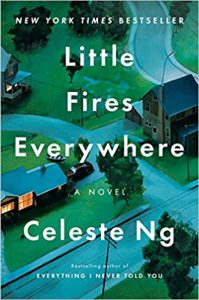 I heard Celeste Ng speak at a United for Libraries hosted author event a few years ago. At the same event, I received an advance copy of her book, Little Fires Everywhere. I enjoyed her remarks but I wasn’t especially interested in reading the book. The book has received a lot of attention since its publication. It is included on many best books of 2017 lists and it is now among three books on Lincoln City Libraries short list for One Book One Lincoln voting. During a recent and long road trip, I had a chance to listen to the audio version of Ng’s book. I wasn’t disappointed.
I heard Celeste Ng speak at a United for Libraries hosted author event a few years ago. At the same event, I received an advance copy of her book, Little Fires Everywhere. I enjoyed her remarks but I wasn’t especially interested in reading the book. The book has received a lot of attention since its publication. It is included on many best books of 2017 lists and it is now among three books on Lincoln City Libraries short list for One Book One Lincoln voting. During a recent and long road trip, I had a chance to listen to the audio version of Ng’s book. I wasn’t disappointed.
Little Fires Everywhere begins with a house on fire and speculation about who is to blame. At the top of the list is the youngest family member – a non-conforming teen rebel. But did she do it and, if so, why? The setting is Shaker Heights, Ohio, and the story evolves from the developing relationships among members of two families – one long rooted in the community and prosperous, and the other (a mother and daughter) impoverished and living day to day under uncertain circumstances. Central are the two mothers – Elena Richardson, a local news reporter, mother of four and a well-connected community member, and Mia Warren, a mysterious artist and single mother of one. Connections evolve and conflict emerges as a result of the attempted adoption of a Chinese-American baby and an ensuing custody battle. In the background is Elena Richardson’s effort to uncover Mia Warren’s true identity.
Lincoln’s three books selected for the all community read are all excellent choices. Celeste Ng’s book is worthy and notable. If chosen, it will make an interesting read and a great source for conversation.
Little Fires Everywhere is Celeste Ng’s second novel. Her debut book is, Everything I Never Told You, an award winning best seller.
Ng, Celeste. Little fires everywhere. (New York: Penguin Press) 2017.
Friday Reads: Petty: The Biography by Warren Zanes
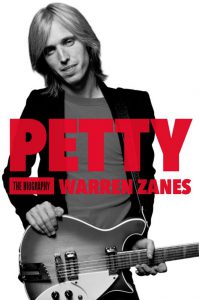 For years, I overlooked the simplicity and beauty of Tom Petty’s music. Some points of clarification at the outset: I would like to acknowledge the contribution of the Heartbreakers to Tom Petty, and it should be noted that the band (both collectively and individually) did a fair amount of side work, including backing Johnny Cash and the Travelling Wilburys (among other things). I owe it to my daughter (11-year old astrology expert and member of the counterculture) for my renewed interest in Petty, and the Heartbreakers. As a youngster, I never really listened to him much. Not that I had anything against him or his music, but I guess I just did not have the appreciation at that time. At any rate, the daughter, oddly and I’m not sure how, became a huge Petty fan. She likely was drawn to his simplicity, musical genius, and willingness to tell it like it is. Speaking of how Tom and the Heartbreakers got hooked up with Johnny Cash, Tom mentions that the band was interested in all forms of American music, pure forms that is, “not what they would call country today. What they would call country today is sort of like bad rock groups with a fiddle.” Tom and the Heartbreakers backed Cash on American II: Unchained. As much as I could go on about Cash, this little review today is about Petty, so let us steer back in that direction.
For years, I overlooked the simplicity and beauty of Tom Petty’s music. Some points of clarification at the outset: I would like to acknowledge the contribution of the Heartbreakers to Tom Petty, and it should be noted that the band (both collectively and individually) did a fair amount of side work, including backing Johnny Cash and the Travelling Wilburys (among other things). I owe it to my daughter (11-year old astrology expert and member of the counterculture) for my renewed interest in Petty, and the Heartbreakers. As a youngster, I never really listened to him much. Not that I had anything against him or his music, but I guess I just did not have the appreciation at that time. At any rate, the daughter, oddly and I’m not sure how, became a huge Petty fan. She likely was drawn to his simplicity, musical genius, and willingness to tell it like it is. Speaking of how Tom and the Heartbreakers got hooked up with Johnny Cash, Tom mentions that the band was interested in all forms of American music, pure forms that is, “not what they would call country today. What they would call country today is sort of like bad rock groups with a fiddle.” Tom and the Heartbreakers backed Cash on American II: Unchained. As much as I could go on about Cash, this little review today is about Petty, so let us steer back in that direction.
Petty, written by former Del Fuegos guitarist Warren Zanes, chronicles Tom’s upbringing, complete with an abusive alcoholic father in 1950’s working class Gainesville, FL. Arguably, the most difficult obstacle in Petty’s childhood was his lack of familial support for his interests and passion (music), but some might argue that being severely beaten around age 5 would be just as bad or worse. At any rate, Tom did not have an easy childhood, and while struggling through the monotony and boredom of school, he did get hooked up with other musicians, notably taking guitar lessons from Don Felder (the Eagles), forming various cover bands, and then the assembly of Mudcrutch. Most of the members of Mudcrutch subsequently became members of the Heartbreakers.
The account provided by Zanes relies on interviews from various people around the band and Petty himself. I think Tom wanted to tell his story, but felt the need to have it done independently, so that it seemed more credible. I can’t say I blame him, as I’ve often read autobiographies (especially by musicians) that come across as braggadocios, even if not intended. This one doesn’t play that way. Petty is such a likeable figure because of his honesty and humility. That is not to say that the duration of the Heartbreakers was without conflict, because it certainly was not. In addition to the Heartbreakers and various producers (notably Jimmy Iovine and Rick Rubin), numerous other prominent figures played a role in his life, such as (to name just a few) close friends Stevie Nicks, Jeff Lynne, Bruce Springsteen, and George Harrison. One of the reasons Petty has appeal (aside from his work with the Heartbreakers) is his work and friendship with these other musicians. For a nice little example of this, check out the performance at George Harrison’s induction into the Rock and Roll Hall of Fame (2004), and a cat named Prince who makes an appearance around 3:29.
Zanes of course also covers personal aspects of Petty’s life, including his relationship with his first wife, Jane Benyo, his kids, and his second wife, Dana York. Zanes also chronicles Tom’s depression and heroin use, and while that certainly is a large part of his story, it does not overwhelm the reader. It just seems to be an honest depiction and part of his story. As far as biographies go, this is one of the better ones.
Zanes, Warren. Petty: The Biography. 2016. Print.
Friday Reads: “Bless Me, Ultima” by Rudolfo Anaya
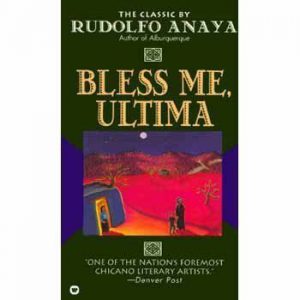 I became motivated to reread this book when I looked at the booklist for The Great American Read program and realized that it had been about forty years since I first encountered this classic “Coming of Age” story.
I became motivated to reread this book when I looked at the booklist for The Great American Read program and realized that it had been about forty years since I first encountered this classic “Coming of Age” story.
With Bless Me, Ultima (1972), the first in a trilogy (followed by the publication of Heart of Aztlan in 1976 and Tortuga in 1979), Anaya follows six-year-old Antonio on his growing-up journey and spins the story by revealing dreams and reality—and blurring the fine line between them from time to time. Anaya says he does not seek characters—they just come to him. So it is with Ultima. Anaya says she appeared in the doorway while he was writing and assured him that the story will not work unless he put her in it. Ultima is a pivotal character in the story. She is a curandera—a healer and teacher, and she guides Antonio gently without prescribing exact choices to make or solutions to problems.
From the first dream sequence to the last (you’ll recognize them, they are in italics), it is clear that Antonio was born to struggle and that his path is marked by having his feet in two different worlds. Throughout the book, he is faced with tests. Some are common tests of childhood, like how to overcome the loneliness of feeling different. Others are extremely unusual and painful tests for a young person to endure and learn from. I feel like this book has resonated with so many readers because even though we may live in different worlds, many of us can really relate to his experience. Are we all on the same journey as Antonio? Struggling to understand good and evil around (and within) us? But are some of us especially lost with no guides or curanderas to show us the way?
The setting and characters ring true to me. The book mirrors my experience in small towns in New Mexico right down to my best friend Lenora’s grandmother—who might very well be the model for Antonio’s mother—speaking only Spanish, warning us against straying to the city (too late—we were already on our way to LA), and feeding us the most heavenly comfort food for breakfast, lunch, and dinner.
The story is told in flat-out beautiful writing, and unless you read the book, you’ll just have to take my word for it that this book has one of the best first paragraphs ever! So I’d suggest you (and your book group) find out for yourselves. This #FridayReads feature is available as a Book Club kit from the Nebraska Library Commission at http://nlc.nebraska.gov/ref/bookclub.
The Great American Read is an eight-part PBS series that explores and celebrates the power of reading, in the context of America’s 100 best-loved novels (as chosen through a national survey). It investigates how and why writers create their fictional worlds, how we as readers are affected by these stories, and what these 100 different books have to say about our diverse nation and our shared human experience. Voting for America’s favorite book opened with the launch of the two-hour premiere episode on May 22 and continues throughout the summer, leading up to the grand finale “favorite” announcement in October 2018. Viewers can vote at pbs.org/greatamericanread and through hashtag voting via Facebook and Twitter using #GreatReadPBS. I think I might be voting for Bless Me Ultima. Which book will you vote for?
Review by Mary Jo Ryan.
#fridayreads
#GreatReadPBS
Friday Reads: Lawn Boy by Jonathan Evison
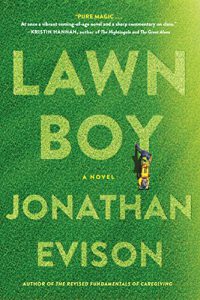 All 5-year-old Mike wanted from life was to go to Disney World. One day, his dad packed him in the car, drove him to an abandoned shipyard, and told him that The Happiest Place on Earth must have closed. That was the day that ol’ Mike Muñoz realizes that life will be a constant disappointment, and just when you think you’re going to get what you want, it will all be taken away.
All 5-year-old Mike wanted from life was to go to Disney World. One day, his dad packed him in the car, drove him to an abandoned shipyard, and told him that The Happiest Place on Earth must have closed. That was the day that ol’ Mike Muñoz realizes that life will be a constant disappointment, and just when you think you’re going to get what you want, it will all be taken away.
Today, Mike is a 22-year-old landscaper (although he prefers the title “topiary artist” for his skills with the hedge-trimmers). He still lives with his mom and his developmentally disabled brother, their dad long gone to parts unknown. He drives a junky car, always one step away from engine failure, and still hangs out with his high school buddy, neither of them with any romantic prospects on the horizon.
When Mike loses his landscaping job for refusing to pick up dog poo, he is determined to do whatever it takes to break free of his hand-to-mouth existence and chase the American Dream, perhaps writing “the great American landscaping novel” along the way. And so begins a series of unfortunate events that will be all too familiar to anyone who has ever tried to escape from the cycle of poverty that holds down a good portion of our society. Though angry and resentful about his lot in life, Mike keeps his sense of humor, even as “The Man” takes everything else away.

